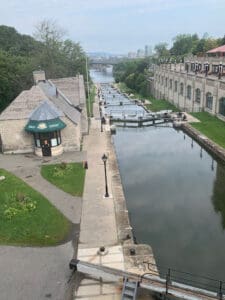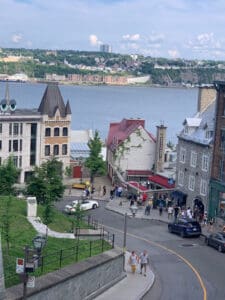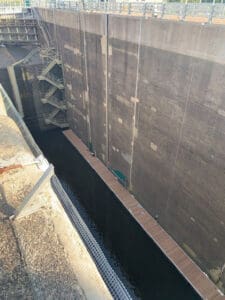
Much has been written about boating on the St. Lawrence River—mostly mis-informed or outdated information, as we soon learned. In summer of 2023, we cruised the St. Lawrence River between Quebec City and Montreal and the Ottawa River to Ottawa, and we are pleased to report the entire trip was a delight.
We completed the American Great Loop in a clockwise direction and crossed our wake at the Statue of Liberty in late June 2023 aboard our Nordic Tug 32, Bessie. With a comfortable and economic cruising speed of 8 mph, the Nordic Tug can also attain 16 or 17 mph if necessary. The point is that it is not necessary to have a high-speed boat to safely cruise on the St. Lawrence and Ottawa Rivers.
We thoroughly enjoyed the summer of 2022 along the southern border of Canada and the Trent-Severn Waterway and were determined to return for another season. A season’s pass for the locks and moorings from Parks Canada is a bargain if cruising plans are longer than 10 days. We obtained ours early in the year to take advantage of the early-purchase discount.

We headed back up the Hudson River and entered the Champlain Canal at Mechanicsville. We refueled at Ferry Dock Marina in Burlington, topping off our tank as Canada fuel prices are much higher. Pump-out is free. We continued north through Lake Champlain, the Chambly Canal, the Richelieu River and the St. Lawrence River at Sorel. Like many others, we had heard conflicting reports about 10-to-15-foot tides, adverse currents and commercial shipping encountered on the St. Lawrence River. Even though we are very experienced cruisers, we confess to some level of apprehension upon entering the St. Lawrence River.
We hoisted our Canadian courtesy flag as we crossed the international border and cleared into Quebec Province at Lacolle, south of St. Jean. We specifically state Quebec Province because Canadian provinces have different clearance procedures. We tied up to the Customs and Immigration dock on the left ascending bank. Two very friendly bilingual officers cleared us in with two questions: currency over $10,000 and firearms. Alcohol was not mentioned, but the preferred answer is “ship’s stores.” They offered that we could have tied up for the night on their dock. They stamped our passports to provide proof of entry.
Remember to set your VHF radio to Canada frequencies. It’s very easy; just look it up in your VHF owner’s manual.
We prefer AquaMaps on our iPad while cruising in US waters, but we think Navionics is better suited for Canada. We have read that AquaMaps has improved their Canadian coverage—we will check it out this summer.
We left the Richelieu River and entered the St. Lawrence River at Sorel, a large industrial city and shipping port. Commercial ships monitor VHF channel 10 in Montreal and channel 12 in Quebec City. Vessel-to-vessel calls are on channels 68 and 8. The St. Lawrence River at Sorel is very wide, so we had no problems staying clear of the ferries and ships. The entry to Marina de Saurel is on the right descending bank at the upstream side of the small island at the entrance to the marina. Do not attempt to enter on the downstream side of the island. The marina has information on tides and currents. We quickly determined we would have more favorable conditions in two days for our journey down to Quebec City. There is a good restaurant at the marina, but we can’t say much about the city.
With the current in our favor, we arrived at Batiscan Marina 5 1/2 hours after departing Marina de Saurel. The current boosted our speed over ground well above the usual 8 mph. In retrospect, we should have continued farther to take maximum advantage of the favorable tidal current. The St. Lawrence River is well buoyed, the channel is very wide and we had no problems staying clear of the several ships that we met. The marina is quite isolated, and the docks are in terrible shape but fine for one overnight. We saw several sailboats while on the St. Lawrence River, providing additional proof that high horsepower is definitely not required!
An early morning start made the most of the favorable current, and we arrived at Vieux Port de Quebec Marina only 5 1/2 hours after departing Batiscan. The Quebec Province Marine Police boat stopped us enroute to check the entry stamp in our passports. They were very professional and friendly and did not come aboard, just tied alongside as we hove-to.
The marina is protected by a lock due to the large tidal range. Call on VHF channel 71 for lock transit and berth assignment. The marina is very secure and has excellent facilities (fuel, water, pumpout, garbage, toilets, showers, laundry, package receipt) and is right in the heart of Quebec City.
We enjoyed the usual tourist attractions, walking everywhere, enjoying a meal at the Chateau Frontenac and touring the Citadel, the Governor General’s residence and Parliament. Quebec is a beautiful, old city with a distinctly European ambiance. Now we have a much better understanding of the Quebecois’ attachment to their French culture—Je me souviens.

Quebec.
If ethanol-free gasoline is needed for your outboard motor or portable generator, be advised that in Canada, premium gasoline (the highest octane and most expensive) is ethanol-free. It is available at a service station a short walk from the marina.
We rented a car and drove down the river to view the minke and beluga whales at Saguenay, a very large fjord off the St. Lawerence River. No need to go out on an expensive whale-watching boat when you can easily view them from the park observation station on the shore. And, knowing what we know now about the tides and currents, we could have easily made the trip aboard Bessie. (Check your insurance policy because some do not cover downstream of Quebec City.)
The marina can advise on the departure time for favorable currents for going back upriver, which in our case was 0500, one-half hour after dead low tide. We transited the lock late in the afternoon, as it closes at night, and tied to the lock outer wall docks for the night at no charge. Fender your vessel well because the harbor tugboats moor at these docks, creating huge wakes. The next morning, we departed right on schedule and arrived at Trois Rivieres Marina nine and a half hours later—favorable current the entire way! Trois Rivieres Marina is in a beautiful park with extensive walking trails. Fuel, water, electricity, toilets, showers and garbage disposal are available.
The following day, we encountered 2 to 3 mph of adverse river current and anchored overnight off the right ascending bank in 20 feet over good holding mud at Isle de Grace anchorage. It is a quiet, beautiful place with many birds to watch and very good protection all around. The river narrows near the approach to Yacht Club Montreal and is an “exhilarating” run against the river current for the last couple of miles. Navionics shows only 4.5 knots of river current, but we slowed to 2 mph speed over ground, even with much higher power settings. Stay close to the right ascending bank to minimize the adverse current.
The marina suffers from wakes from passing tourist and pleasure boats, so fender the best you can. Pumpout, water and power are available at each slip, but it has no fuel. The marina is very secure and has excellent laundry, toilets, showers and garbage disposal. They will not accept packages. Museums, restaurants and grocery stores are within walking distance.
Entry into the Canal de La Rive Sud at Seaway Locks is by reservation online, and separate payment is required. Refer to www.Greatlakes-seaway.com. These locks are huge in order to accommodate container ships. St. Lambert Lock has a telephone on the dock to call the lockmaster to confirm your arrival. Your clearance to enter is by loudspeaker, and the channel is wide and clearly marked. Cote Ste. Catherine Lock is next. Plan your route from Ste. Catherine Lock carefully as the canal leaves the St. Lawrence River. The good news is that currents are no longer a concern once past St. Lambert Lock.
Ste. Anne de Bellevue Lock is the entry into the Ottawa River and is a Parcs Canada property. Call the lockmaster on VHF 68 from the blue line for entry. The lock contains a floating dock, eliminating the need for line-handling. There was a lot of pleasure vessel traffic in this area, so a good lookout is essential. We tied to the downstream lock wall for the night and transited the lock the following morning. There are many restaurants and ice cream shops in this area.

Carillon Lock is immense with a dam and a large hydroelectric plant. Tours are available. The very well-sheltered dock before the lock where we spent the night has a large park adjoining it. The lock contains a floating dock, eliminating the need for line handling. The lockmaster cautioned us not to moor at the top of the lock because it is exposed to weather and can become dangerous. The following day, we anchored overnight on the left bank in 11 feet over good holding mud at approximately 45° 34.881 N and 75° 14.176 W. It is a remote anchorage with no shore access.
We arrived at Ottawa’s Flight of Locks after an easy, three-hour run. The eight locks lifted us 80 feet from the Ottawa River up into the Rideau Canal. From arrival at the locks to the top of the locks took over five hours. We tied to the canal walls in the heart of the city. Security is a concern here, as several homeless people were encamped about. Ottawa has beautiful parks and historic buildings, and we enjoyed the colorful flag ceremony in a nearby park. Now, in the Rideau Canal, our adventure continues. n
Harry Hungate and his wife, Jane Lothrop, spend the summer months aboard Bessie, their 2004 Nordic Tug 32. They are now in their fourth year of cruising in eastern North America.
